Let's Talk About Renewable Energy #1: Hydropower
The topic for today is renewable energy with the aim to provide a better understanding about these so-called ‘green’ sources of energy, to learn how they are harnessed and most importantly how they are affecting our daily lives and the environment in which we live in.
For starters let us define first what renewable energy sources are. Renewable energy sources are basically energy sources that regenerate or replenish on a human timescale. It includes sunlight(solar), wind, hydropower, geothermal and biomass. When we were in high school and even today we usually use the terms ‘renewable’ source and ‘alternative’ source interchangeably. There is a subtle difference between a renewable energy source and an alternative energy source. The term ‘alternative’ is used to refer energy sources that are non-traditional. It is defined as an energy source that has a low environmental impact. We can consider renewable sources as alternatives, but it doesn’t necessary mean that all alternatives are renewables.
(Note: An example of a traditional source are fossil fuels.)
This time we are going to discuss one type of renewable energy source which is hydropower. And our main objective is to explain/answer the following before the end of this article:
- What is hydropower?
- How does a hydropower plant operate?
- How does harnessing hydropower affects us?
What is hydropower?

The definition of hydropower is plain simple. The greek word 'hydro' translates to water. The full meaning obviously translates to water power or power of water. It's not really something new as most us are familiar with this kind of renewable energy. We've read it in our science books and even watched documentaries about it. Hydropower or which is also referred today as hydroelectric power is harnessed from moving water. Flowing, falling or any type of water movement contains a certain amount of free energy. And because human beings are rather smart we established means on how to harness this free energy and turn it to something beneficial to us, like electricity. But before we dive too deep, do you know that hydropower was not first used as a source of electricity? Even before the industrial revolution and the discovery of electricity, hydropower has always been there.
Some History...
In ancient times, hydropower had played a relevant role in agriculture, woodworking and mining. People harnessed this energy to turn their grains into flour which would later be turned to bread. Of course it was not only limited to grains. It was also used to process lumber, textile, metals and even stone products.[1] 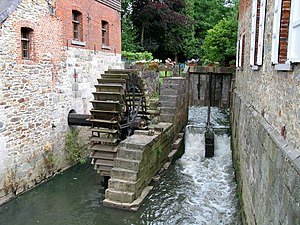
Mills and their Wheels
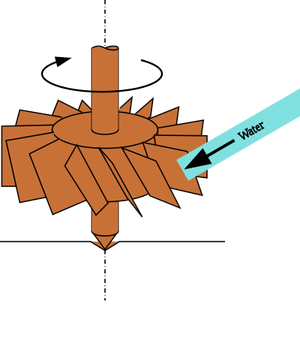
Hydropower Now...
Although water mills are still present most of them are not used and this is due to the industrial revolution which sped up development at an exponential rate. With many great minds at that time the first electrical generator was also developed. Fusing these two technologies they arrived of what we know today as hydroelectricity.
In 1878 the first house was lit by hydroelectricity. It was the house of the Sir William Armstrong. This guy is so awesome here's his brief description from wiki in case you're being lazy to click the link. XD
Armstrong was knighted in 1859 after giving his gun patents to the government. In 1887, in Queen Victoria's golden jubilee year, he was raised to the peerage as Baron Armstrong of Cragside, becoming the first engineer – and, indeed, the first scientist – to join the House of Lords.
Sorry for being a little off topic there. After the incident of lighting the first household harnessing hydroelectricity for power generation have spread like a wildfire. Just before the end of the 20th century there are already hundreds of hydroelectric power stations in North America alone which powered up thousands of households at that time. And the trend didn't end as many more power stations were built with higher power output and capacity.
At present, these are the four dams with the highest power capacities exceeding 10,000 MW:
| Dam | Capacity |
|---|---|
| Three Gorges Dam | 22,500 MW |
| Itaipu Dam Brazil | 14,000 MW |
| Xiluodu Dam | 13,860 MW |
| Guri Dam | 10,200 MW |
𝖲𝗈𝗎𝗋𝖼𝖾: 𝖶𝗈𝗋𝗅𝖽 𝖶𝖺𝗍𝖼𝗁 𝖨𝗇𝗌𝗍𝗂𝗍𝗎𝗍𝖾
Power Generation and Energy Conversions
There are four main methods of harnessing and generating power and these are the conventional dams, pump-storage systems, run-of-the-river and tide. But we will focus this discussion on the conventional dams as this generation method is the one we are most familiar with. It is also the method which produces the highest power output among the four.
How does a Hydroelectric Dam Operate?
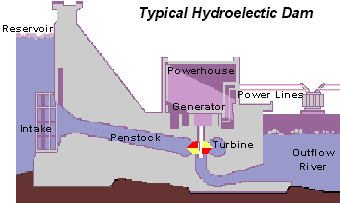
Before anything else we need to know that most dams were not built for power generation but for irrigation and flood control. Only hydroelectric dams are built for such purposes.
Hydroelectric Dams are built on river systems that have large elevation gaps and the reason for this is to utilize the force of gravity. The larger the drop elevation the more potential energy it will build up. The formula for potential energy is m x g x h (mass x gravity x height). It means that as height increases the potential energy value also increases.
A hydroelectric dam became a mainstream power generation device because it has an excellent control over the water flow. A reservoir is built behind as a water storage. The intake below the dam acts as a floodgate which regulates the water flow; it is opened if it's time to generate power and is usually closed when there is insufficient water in the reservoir to propel the turbine.
When the floodgates are opened the water flows through the penstock. In this process the previous potential energy is converted to kinetic energy (KE). Just an example let us assume that we are in an equilibrium and PE = KE. The formula for KE is 1/2mv^2. If the converted potential energy value is high it means that the speed value(v) is also high. The faster the speed of the water flow the faster the turbine spins. From KE it is converted to mechanical energy by the hydraulic turbine's rotational motion.
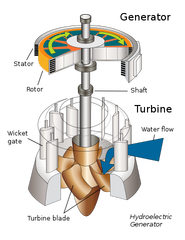
Summary of Energy Conversions
Potential Energy(Flood Gate Closed) -->> Kinetic Energy (Water Flows through the penstock) -->> Mechanical Energy(Turbine Spins) -->> Electrical Energy(Rotor Spins Producing Electricity)
Pros and Cons of Harnessing Hydropower
Pros
1. It's Cheap!
The energy source is FREE making the operations cost very low. The bulk of expenditure will go to dam and plant construction. And because this kind of power is produced at lower costs it is expected the selling price to the consumers is also cheaper.
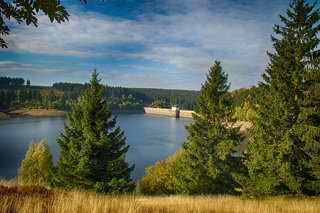
Depending on a power plant's size the budget needed for construction is in several millions to billions. But a well-maintained plants lasts very long. According to wikipedia and it's sources some plants last even 50-100 years! Take the Three Gorges Dam in China for example. It is estimated that the the construction cost will be covered after 5-8 years of full generation. So after the 8th year the plant's only liability is the annual maintenance cost and taxes(of course), aside from that everything is pure profit.
2. It's Clean!
Hydoelectric plants don't burn anything so they do not release of CO2.
While carbon dioxide is initially produced during construction of the project, and some methane is given off annually by reservoirs, hydro normally has the lowest lifecycle greenhouse gas emissions for power generation. Compared to fossil fuels generating an equivalent amount of electricity, hydro displaced three billion tonnes of CO2 emissions in 2011.
3. It's flexible in many ways!
a. It is very easy and quick to control
Power adjustments can easily be implemented because hydraulic turbines have a fast start up time. It is also the same for decreasing the power generation. This made the efficiency of the plant operation very high.
b. Storage Facility
Another good thing with hydroelectric power plants is the dam. Having a resevoir is an assurance of having spare power supply in cases when the demand is high. Some reservoirs can also be used for recreational activities like swimming and boating.
c. The outflow is still usable
After the water passed through the turbine it would flow to the river below. The flowing water is commonly used to irrigate farm fields.
Cons
1. Water Cycle Dependency
The amount of precipitation determines the amount of water available for hydropower production. Droughts are always accompanied by fast evaporation rates which greatly diminishes the stored water, sometimes it even render the unavailability of power plant operations.
2. Environmental Impacts
a. Ecology

b. Atmosphere
There are more methane emissions from reservoirs of power plants in the tropics because it is more humid. Environmental conditions promotes the decay of plant material in flooded areas which produces methane.
3. Failure Risks
Have you watched the movie Evan Almighty? The materials used in the dam were sub-standard and at the later part of the movie the dam broke. This is one example of failure risks(minus the fiction). There are three main reasons why is there failure risks and these are poor construction, natural disasters and sabotage. Large dams hold more water making them more susceptible to these risks.
Final Thoughts
We learned many things today about hydropower. From the cool water mills, when they became obsolete and were replaced by hydraulic turbines up to the process of harnessing electricity from a hydroelectric power plant. We also learned about the effects of hydropower to our environment. Personally if I weigh the pros and cons of hydropower I think it has a more positive impact in our society and environment as a whole. The flowing water is free and if we can develop better electrical storage facilities we can take the opportunity of harnessing power especially when there is low demand. Of course we also have to improve the mitigation process of the damages the dams would bring like the case of the salmons. What do you think?
It's 1 A.M. here. I'll write the credits and it's time to sleep. Haha. I hope you learned something. Good night. XD
Credits:
[1] - [2] - [3] - [4]
https://en.wikipedia.org/wiki/Hydropower
https://en.wikipedia.org/wiki/Watermill
https://en.wikipedia.org/wiki/Water_wheel
https://en.wikipedia.org/wiki/Hydroelectricity
https://www.eia.gov/energyexplained/index.cfm?page=hydropower_home
https://water.usgs.gov/edu/hyhowworks.html
https://www.nationalgeographic.com/environment/global-warming/hydropower/
https://www.internationalrivers.org/dams-and-migratory-fish
Great thanks for explaining about renewable energy.
There are clearly no free lunches, and this holds for any source of energy.
One thing you didn't mention is the fact that the area above the dam is usually flooded (which may yield another ecological issue). On different grounds, building the dam may also be not very eco-friendly (a lot of concrete in there, that needs to be produced somehow).
This being said, hydro is very clean, but maybe not 100% clean (such a thing does not exist IMO).
Thank you very much for the additional info sir!
I agree with that, If not I'm wrong it's because of siltation. As time flies sediment deposits build up under the dam making the it shallower.
Yes there's no such thing as a perfect energy source. We have no choice but to pick the better ones and improve it along the way.
Again, many thanks to you guys in @steemstem and @curie! You're all awesome. XD
Nice write-up, you did an excellent job of explaining the tech in a straightforward and clear manner.
The backlash against renewable energy is really interesting, particularly in the US. Part of that is a tremendous misunderstanding of how these technologies function (e.g. google the US senator who stated that building windmill farms will 'use up all the wind'), but at its core I think it's the reliable old concern of progress pushing out the average Joe - despite Joe being pushed out of the fossil fuel energy sector just as readily right now. Coal will never be what it was twenty years ago, even if it was the only energy source we ever used - automation has simply come to far and increased profits too greatly for things to ever return to what they were.
The agree to you @crossback7. I just googled the senator. LOL XD
there are other sources of hydro power which haven't been tapped yet.
the Gulf Stream comes to mind...all that moving water.
Eight Billion Gallons a minute...no damn dam needed.
Thanks for this comment sir! There's no doubt that the gulf stream has highest potential among all hydropower sources. The problem is the method of harnessing that power. If I'm not wrong there are many proposals but until now only prototype underwater turbines are being tested.
there are Options.
buy a houseboat.
live on it in the GulfStream.
drop anchor.
let the flowing waters of the gulf stream
turn your propellors..
generating electricity..
Thank you very much @steemiteducation team! You guys rock XD
You deserve it. Heck of a write-up.. PS interesting trivia, what noble deeds one might be knighted for!:
"Armstrong was knighted in 1859 after giving his gun patents to the government."
My country has 40% of electricity generated by hydro power but believe me it is not easy. let me tell you the reasons.
you need to have consistent water supply throughout the year. (but its not the case - summer no water , in rainy time too much water and it create huge problems with mud extracting through tunnels . winter - lakes are frozen )
Very Costly to install. - You have to carve a tunnel through a lake. and lake should build by a river which have constant water supply.
Your power generation is static.
True . After initial investment . its going to be less maintenance. still with my life experience other power options have much more reliability than hydropower
subd :)
Thanks for leaving a comment! Surely there are always exceptions. Mind if I ask where are you from? :D
I am from Sri lanka
Hmm interesting. Durable power will be the future!
Thanks ft. You rock. I'll DM you later when I joined the group :D
This post has received a 0.63 % upvote from @drotto thanks to: @steemstem-bot.
Thanks XD
Galing nman talaga. Alam na this... :D
Thanks ate . Andaming Angel's nito XD
Oo nga dapat matuloy n yan. :P
your brain is still productive at 1am. I'm amazed haha! this is really informative. I agree, it's good if our government would be able to develop a better electrical storage. but for sure it would really take long knowing our govt 😆
Nasanay na po @enjieneer. XD
Thanks for this comment. I also hope so but I think they have other 'priorities' that's why we are left behind by our neighbors. :)